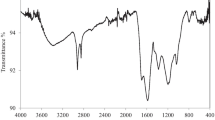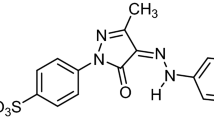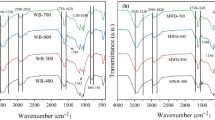Abstract
Nature-based solutions (NBSs) for remediation of various emerging contaminants have gained impetus during the last few decades. In the current study, watermelon (citrullus lanatus), a highly consumed seasonal fruit, was used as a feedstock waste biomass for biochar synthesis through valorization of watermelon rinds. The watermelon biochar (WM-BC) was synthesized through slow pyrolysis at 550°C under anoxic conditions. Langmuir model with R2>99, was found to best fit the adsorption isotherm, and the adsorption kinetics was best described by the pseudo-second-order model. Various characterization tools including FTIR, SEM, BET, XRD, and TEM were used to evaluate the surface morphology of the biochar. The removal efficiency increased from 35% (dosage = 0.4 g), to 81% at WM-BC dosage of 2 g. A maximum adsorption capacity of 115.61 mg/g was found. The results from kinetic and isotherm model model suggested that the adsorption was favorable and multilayer adsorption can be considered. The adsorption mechanism was found to be governed by the co-existing factors such as hydrogen bonding, electrostatic interactions, and aromatic interactions. Results suggest that WM-BC has high potential to be employed as an adsorbent for efficient remediation of methylene blue dyes from aqueous solutions.






Similar content being viewed by others
References
Wan, Z., Sun, Y., Tsang, D. C. W., Yu, I. K. M., Fan, J., Clark, J. H., & Ok, Y. S. (2019). A sustainable biochar catalyst synergized with copper heteroatoms and CO2 for singlet oxygenation and electron transfer routes. Green Chemistry, 21(17), 4800–4814. https://doi.org/10.1039/C9GC01843C
Donkadokula, N. Y., Kola, A. K., Naz, I., & Saroj, D. (2020). A review on advanced physico-chemical and biological textile dye wastewater treatment techniques. Reviews in Environmental Science and Biotechnology, 19(3), 543–560. https://doi.org/10.1007/S11157-020-09543-Z/TABLES/5
Liu, L., Chen, Z., Zhang, J., Shan, D., Wu, Y., Bai, L., & Wang, B. (2021). Treatment of industrial dye wastewater and pharmaceutical residue wastewater by advanced oxidation processes and its combination with nanocatalysts: A review. Journal of Water Process Engineering, 42, 102122. https://doi.org/10.1016/J.JWPE.2021.102122
Zhang, P., O’Connor, D., Wang, Y., Jiang, L., Xia, T., Wang, L., et al. (2020). A green biochar/iron oxide composite for methylene blue removal. Journal of Hazardous Materials, 384, 121286. https://doi.org/10.1016/J.JHAZMAT.2019.121286
Lakshmipathy, R., & Sarada, N. C. (2015). Methylene blue adsorption onto native watermelon rind: batch and fixed bed column studies. Desalination and Water Treatment, New pub: Balaban, 57(23), 10632–10645. https://doi.org/10.1080/19443994.2015.1040462
Al-Tohamy, R., Ali, S. S., Li, F., Okasha, K. M., Mahmoud, Y. A. G., Elsamahy, T., et al. (2022). A critical review on the treatment of dye-containing wastewater: Ecotoxicological and health concerns of textile dyes and possible remediation approaches for environmental safety. Ecotoxicology and Environmental Safety, 231, 113160. https://doi.org/10.1016/J.ECOENV.2021.113160
Tkaczyk, A., Mitrowska, K., & Posyniak, A. (2020). Synthetic organic dyes as contaminants of the aquatic environment and their implications for ecosystems: A review. Science of The Total Environment, 717, 137222. https://doi.org/10.1016/J.SCITOTENV.2020.137222
Le, T. M. H., Singto, S., Sajomsang, W., Mongkolnavin, R., Nuisin, R., Painmanakul, P., & Sairiam, S. (2021). Hydrophobic PVDF hollow fiber membrane modified with pulse inductively coupling plasma activation and chloroalkylsilanes for efficient dye wastewater treatment by ozonation membrane contactor. Journal of Membrane Science, 635, 119443. https://doi.org/10.1016/J.MEMSCI.2021.119443
Berkessa, Y. W., Lang, Q., Yan, B., Kuang, S., Mao, D., Shu, L., & Zhang, Y. (2019). Anion exchange membrane organic fouling and mitigation in salt valorization process from high salinity textile wastewater by bipolar membrane electrodialysis. Desalination, 465, 94–103. https://doi.org/10.1016/J.DESAL.2019.04.027
Zhao, J., Liu, H., Xue, P., Tian, S., Sun, S., & Lv, X. (2021). Highly-efficient PVDF adsorptive membrane filtration based on chitosan@CNTs-COOH simultaneous removal of anionic and cationic dyes. Carbohydrate Polymers, 274, 118664. https://doi.org/10.1016/J.CARBPOL.2021.118664
Pandey, D., Daverey, A., & Arunachalam, K. (2020). Biochar: Production, properties and emerging role as a support for enzyme immobilization. Journal of Cleaner Production, 255, 120267. https://doi.org/10.1016/J.JCLEPRO.2020.120267
Pandey, D., Daverey, A., Dutta, K., Yata, V. K., & Arunachalam, K. (2022). Valorization of waste pine needle biomass into biosorbents for the removal of methylene blue dye from water: Kinetics, equilibrium and thermodynamics study. Environmental Technology & Innovation, 25, 102200. https://doi.org/10.1016/J.ETI.2021.102200
Han, Q., Wang, J., Goodman, B. A., Xie, J., & Liu, Z. (2020). High adsorption of methylene blue by activated carbon prepared from phosphoric acid treated eucalyptus residue. Powder Technology, 366, 239–248. https://doi.org/10.1016/J.POWTEC.2020.02.013
Bu, J., Yuan, L., Zhang, N., Liu, D., Meng, Y., & Peng, X. (2020). High-efficiency adsorption of methylene blue dye from wastewater by a thiosemicarbazide functionalized graphene oxide composite. Diamond and Related Materials, 101, 107604. https://doi.org/10.1016/J.DIAMOND.2019.107604
Reza, M. S., Yun, C. S., Afroze, S., Radenahmad, N., Bakar, M. S. A., Saidur, R., & Azad, A. K. (2020). Preparation of activated carbon from biomass and its’ applications in water and gas purification, a review. Arab Journal of Basic and Applied Sciences, 27(1), 208–238. https://doi.org/10.1080/25765299.2020.1766799
Shaheen, S. M., Niazi, N. K., Hassan, N. E. E., Bibi, I., Wang, H., Tsang, D. C. W., et al. (2018). Wood-based biochar for the removal of potentially toxic elements in water and wastewater: A critical review. International Materials Reviews, 64(4), 216–247. https://doi.org/10.1080/09506608.2018.1473096
Lin, H., Chen, K., Du, L., Gao, P., Zheng, J., Liu, Y., & Ma, L. (2021). Efficient and selective adsorption of methylene blue and methyl violet dyes by yellow passion fruit peel. Environmental Technology, 43(23), 3519–3530. https://doi.org/10.1080/09593330.2021.1924288
Foo, K. Y., & Hameed, B. H. (2012). Potential of jackfruit peel as precursor for activated carbon prepared by microwave induced NaOH activation. Bioresource Technology, 112, 143–150. https://doi.org/10.1016/J.BIORTECH.2012.01.178
Jawad, A. H., Rashid, R. A., Ishak, M. A. M., & Ismail, K. (2018). Adsorptive removal of methylene blue by chemically treated cellulosic waste banana (Musa sapientum) peels., 12(6), 809–819. https://doi.org/10.1080/16583655.2018.1519893
Dai, H., Chen, Y., Ma, L., Zhang, Y., & Cui, B. (2021). Direct regeneration of hydrogels based on lemon peel and its isolated microcrystalline cellulose: Characterization and application for methylene blue adsorption. International Journal of Biological Macromolecules, 191, 129–138. https://doi.org/10.1016/J.IJBIOMAC.2021.09.063
Senthil Kumar, P., Fernando, P. S. A., Ahmed, R. T., Srinath, R., Priyadharshini, M., Vignesh, A. M., & Thanjiappan, A. (2014). Effect of temperature on the adsorption of methylene blue dye onto sulfuric acid–treated orange peel. Chemical Engineering Communications, 201(11), 1526–1547. https://doi.org/10.1080/00986445.2013.819352
Hashem, A. H., Saied, E., & Hasanin, M. S. (2020). Green and ecofriendly bio-removal of methylene blue dye from aqueous solution using biologically activated banana peel waste. Sustainable Chemistry and Pharmacy, 18, 100333. https://doi.org/10.1016/J.SCP.2020.100333
Li, H., Xiong, J., Xiao, T., Long, J., Wang, Q., Li, K., et al. (2019). Biochar derived from watermelon rinds as regenerable adsorbent for efficient removal of thallium(I) from wastewater. Process Safety and Environmental Protection, 127, 257–266. https://doi.org/10.1016/J.PSEP.2019.04.031
Üner, O., Geçgel, Ü., & Bayrak, Y. (2019). Preparation and characterization of mesoporous activated carbons from waste watermelon rind by using the chemical activation method with zinc chloride. Arabian Journal of Chemistry, 12(8), 3621–3627. https://doi.org/10.1016/J.ARABJC.2015.12.004
Ahmed, W., Mehmood, S., Núñez-Delgado, A., Ali, S., Qaswar, M., Shakoor, A., et al. (2021). Enhanced adsorption of aqueous Pb(II) by modified biochar produced through pyrolysis of watermelon seeds. Science of The Total Environment, 784, 147136. https://doi.org/10.1016/J.SCITOTENV.2021.147136
Jawad, A. H., Ngoh, Y. S., & Radzun, K. A. (2018). Utilization of watermelon ( Citrullus lanatus ) rinds as a natural low-cost biosorbent for adsorption of methylene blue: Kinetic, equilibrium and thermodynamic studies. Journal of Taibah University for Science, 12(4), 371–381. https://doi.org/10.1080/16583655.2018.1476206
Abdelfattah, A., Ali, S. S., Ramadan, H., El-Aswar, E. I., Eltawab, R., Ho, S. H., et al. (2023). Microalgae-based wastewater treatment: Mechanisms, challenges, recent advances, and future prospects. Environmental Science and Ecotechnology, 13, 100205. https://doi.org/10.1016/J.ESE.2022.100205
Ali, S. S., Al-Tohamy, R., Mahmoud, Y. A. G., Kornaros, M., Sun, S., & Sun, J. (2022). Recent advances in the life cycle assessment of biodiesel production linked to azo dye degradation using yeast symbionts of termite guts: A critical review. Energy Reports, 8, 7557–7581. https://doi.org/10.1016/J.EGYR.2022.05.240
Zhang, B., Wu, Y., & Cha, L. (2019). Removal of methyl orange dye using activated biochar derived from pomelo peel wastes: Performance, isotherm, and kinetic studies, 41(1), 125–136. https://doi.org/10.1080/01932691.2018.1561298
Liu, Y., Zhao, X., Li, J., Ma, D., & Han, R. (2012). Characterization of bio-char from pyrolysis of wheat straw and its evaluation on methylene blue adsorption. Desalination and Water Treatment, New pub: Balaban, 46(1–3), 115–123. https://doi.org/10.1080/19443994.2012.677408
Chen, X., Chen, G., Chen, L., Chen, Y., Lehmann, J., McBride, M. B., & Hay, A. G. (2011). Adsorption of copper and zinc by biochars produced from pyrolysis of hardwood and corn straw in aqueous solution. Bioresource Technology, 102(19), 8877–8884. https://doi.org/10.1016/J.BIORTECH.2011.06.078
Zama, E. F., Zhu, Y. G., Reid, B. J., & Sun, G. X. (2017). The role of biochar properties in influencing the sorption and desorption of Pb(II), Cd(II) and As(III) in aqueous solution. Journal of Cleaner Production, 148, 127–136. https://doi.org/10.1016/J.JCLEPRO.2017.01.125
Tomczyk, A., Sokołowska, Z., & Boguta, P. (2020). Biochar physicochemical properties: Pyrolysis temperature and feedstock kind effects. Reviews in Environmental Science and Biotechnology, 19(1), 191–215. https://doi.org/10.1007/S11157-020-09523-3/TABLES/3
Bush, R. E., Bale, C. S. E., Powell, M., Gouldson, A., Taylor, P. G., & Gale, W. F. (2017). The role of intermediaries in low carbon transitions – Empowering innovations to unlock district heating in the UK. Journal of Cleaner Production, 148, 137–147. https://doi.org/10.1016/j.jclepro.2017.01.129
Vijayaraghavan, K. (2020). The importance of mineral ingredients in biochar production, properties and applications. Critical Reviews in Environmental Science and Technology, 51(2), 113–139. https://doi.org/10.1080/10643389.2020.1716654
Chen, K., Li, H., Kong, L., Peng, Y., Chen, D., Xia, J., & Long, J. (2018). Biosorption of thallium(I) and cadmium(II) with the dried biomass of pestalotiopsis sp. FW-JCCW: Isotherm, kinetic, thermodynamic and mechanism. Desalination and Water Treatment, 111, 297–309. https://doi.org/10.5004/DWT.2018.22199
Zhang, G., Fan, F., Li, X., Qi, J., & Chen, Y. (2018). Superior adsorption of thallium(I) on titanium peroxide: Performance and mechanism. Chemical Engineering Journal, 331, 471–479. https://doi.org/10.1016/j.cej.2017.08.053
Cao, X., Sun, S., & Sun, R. (2017). Application of biochar-based catalysts in biomass upgrading: A review. RSC Advances, 7(77), 48793–48805. https://doi.org/10.1039/C7RA09307A
Gabhane, J. W., Bhange, V. P., Patil, P. D., Bankar, S. T., & Kumar, S. (2020). Recent trends in biochar production methods and its application as a soil health conditioner: A review. SN Applied Sciences 2020 2:7, 2(7), 1–21. https://doi.org/10.1007/S42452-020-3121-5
Wang, Y., Xiao, X., Xu, Y., & Chen, B. (2019). Environmental effects of silicon within biochar (sichar) and carbon-silicon coupling mechanisms: A critical review. Environmental Science and Technology, 53(23), 13570–13582. https://doi.org/10.1021/ACS.EST.9B03607/ASSET/IMAGES/MEDIUM/ES9B03607_0009.GIF
Bakshi, S., Banik, C., & Laird, D. A. (2020). Estimating the organic oxygen content of biochar. Scientific Reports 2020 10:1, 10(1), 1–12. https://doi.org/10.1038/s41598-020-69798-y
Franciski, M. A., Peres, E. C., Godinho, M., Perondi, D., Foletto, E. L., Collazzo, G. C., & Dotto, G. L. (2018). Development of CO2 activated biochar from solid wastes of a beer industry and its application for methylene blue adsorption. Waste Management, 78, 630–638. https://doi.org/10.1016/J.WASMAN.2018.06.040
Liu, S., Li, J., Xu, S., Wang, M., Zhang, Y., & Xue, X. (2019). A modified method for enhancing adsorption capability of banana pseudostem biochar towards methylene blue at low temperature. Bioresource Technology, 282, 48–55. https://doi.org/10.1016/J.BIORTECH.2019.02.092
Ayub, A., Raza, Z. A., Majeed, M. I., Tariq, M. R., & Irfan, A. (2020). Development of sustainable magnetic chitosan biosorbent beads for kinetic remediation of arsenic contaminated water. International Journal of Biological Macromolecules, 163, 603–617. https://doi.org/10.1016/J.IJBIOMAC.2020.06.287
Yu, K. L., Lee, X. J., Ong, H. C., Chen, W. H., Chang, J. S., Lin, C. S., et al. (2021). Adsorptive removal of cationic methylene blue and anionic Congo red dyes using wet-torrefied microalgal biochar: Equilibrium, kinetic and mechanism modeling. Environmental Pollution, 272, 115986. https://doi.org/10.1016/J.ENVPOL.2020.115986
Ubando, A. T., Felix, C. B., & Chen, W. H. (2020). Biorefineries in circular bioeconomy: A comprehensive review. Bioresource Technology, 299, 122585. https://doi.org/10.1016/J.BIORTECH.2019.122585
Shindhal, T., Rakholiya, P., Varjani, S., Pandey, A., Ngo, H. H., Guo, W., et al. (2021). A critical review on advances in the practices and perspectives for the treatment of dye industry wastewater. Bioengineered, 12(1), 70–87. https://doi.org/10.1080/21655979.2020.1863034
Khan, A. F., Ahad, A., Shah, S. S., & Farooqui, M. (2021). Adsorption of crystal violet dye using Platanus orientalis (Chinar tree) leaf powder and its biochar: equilibrium, kinetics and thermodynamics study. International Journal of Environmental Analytical Chemistry, 1–21. https://doi.org/10.1080/03067319.2021.1931854
Acknowledgements
Authors are thankful to Prof. (Dr.) Devendra Sharma, Vice-Chancellor, Shri Ramswaroop Memorial University for support in conduction of this study. The constant motivation from our families in conduction of this study is highly appreciated. The authors also extended their appreciation for the support provided by USIC, B. B. A. University, Lucknow.
Availability of Data and Materials
Data will be made available on reasonable request.
Author information
Authors and Affiliations
Contributions
SS: conceptualization, methodology, writing—reviewing and editing. RK: software, writing—original draft preparation, writing—reviewing and editing. MMS: writing—original draft preparation. SZ: writing—reviewing and editing. KA: reviewing and editing.
Corresponding author
Ethics declarations
Ethics Approval and Consent to Participate
Not applicable.
Consent for Publication
Not applicable.
Competing Interests
The authors declare no competing interests.
Additional information
Publisher’s Note
Springer Nature remains neutral with regard to jurisdictional claims in published maps and institutional affiliations.
Saurabh Shukla and Ramsha Khan share first authorship.
Rights and permissions
Springer Nature or its licensor (e.g. a society or other partner) holds exclusive rights to this article under a publishing agreement with the author(s) or other rightsholder(s); author self-archiving of the accepted manuscript version of this article is solely governed by the terms of such publishing agreement and applicable law.
About this article
Cite this article
Shukla, S., Khan, R., Srivastava, M.M. et al. Valorization of Waste Watermelon Rinds as a Bio-adsorbent for Efficient Removal of Methylene Blue Dye from Aqueous Solutions. Appl Biochem Biotechnol (2023). https://doi.org/10.1007/s12010-023-04448-3
Accepted:
Published:
DOI: https://doi.org/10.1007/s12010-023-04448-3




